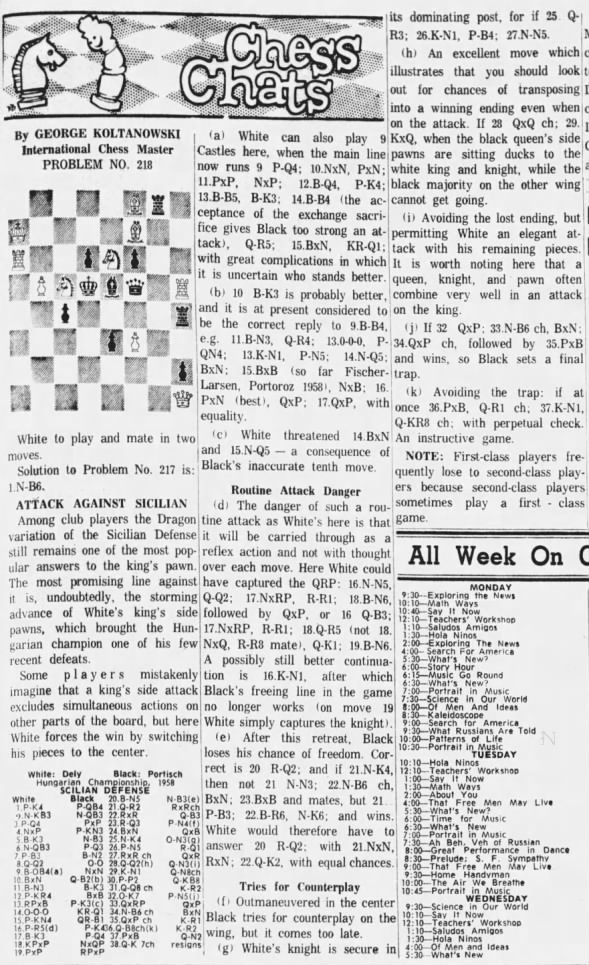< Prev Index Next >
 Chess Chats 07 Feb 1960, Sun The Press Democrat (Santa Rosa, California) Newspapers.com
Chess Chats 07 Feb 1960, Sun The Press Democrat (Santa Rosa, California) Newspapers.com
Attack Against Sicilian
Among club players the Dragon variation of the Sicilian Defense still remains one of the most popular answers to the king's pawn. the most promising line against it is, undoubtedly, the storming advance of White's king's side pawns, which brought the Hungarian champion one of his few recent defeats.
Some players mistakenly imagine that a king's side attack excludes simultaneous actions on other parts of the board, but here White forces the win by switching his pieces to the center.
Hungarian Championship, 1958
Peter Dely (white) vs. Lajos Portisch (black)
Sicilian Defense: Dragon Variation, Yugoslav Attack, Main Line
(a) White can also play 9 Castles here, when the main line now runs 9. P-Q4 10. NxN PxN; 11. PxP NxP; 12. B-Q4 P-K4; 13. B-B5 B-K3; 14. B-B4 (the acceptance of the exchange sacrifice gives Black too strong an attack), Q-R5; 15. BxN KR-Q1; with great complications in which it is uncertain who stands better.
(b) 10. B-K3 is probably better, and it is at present considered to be the correct reply to 9. B-B4 e.g., 11. B-N3 Q-R4; 12. O-O-O P-QN4; 13. K-N1 P-N5; 14. N-Q5 BxN; 15. BxB (so far Fischer-Larsen, Portoroz 1958), NxB; 16. PxN (best), QxP; 17. QxP, with equality.
(c) White threatened 14. BxN and 15. N-Q5 — a consequence of Black's inaccurate tenth move.
Routine Attack Danger
(d) The danger of such a routine attack as White's here is that it will be carried through as a reflex action and not with thought over each move. Here White could have captured the QRP; 16. N-N5 Q-Q2; 17. NxRP R-R1; 18. Q-R5 (not 18. NxQ R-R8 mate) Q-K1; 19. B-N6. A possibly still better continuation is 16. K-N1, after which Black's freeing line in the game no longer works (on move 19 White simply captures the knight).
(e) After this retreat, Black loses his chance of freedom. Correct is 20. R-Q2; and if 21. N-K4 then not 21. N-N3 22. N-B6ch, BxN; 23. BxB and mates, but 21. P-B3; 22. B-R6 N-K6 and wins. White would therefore have to answer 20. R-Q2; with 21. NxN RxN; 22. Q-K2, with equal chances.
Tries for Counterplay
(f) Outmaneuvered in the center Black tries for counterplay on the wing, but it comes too late.
(g) White's knight is secure in its dominating post, for if 24. Q-R3; 26. K-N1, P-B4; 27. N-N5.
(h) An excellent move which illustrates that you should look out for chances of transposing into a winning ending even when on the attack. If 28. QxQch; 29. KxQ, when the black queen's side pawns are sitting ducks to the white king and knight, while the black majority on the other wing cannot get going.
(i) Avoiding the lost ending, but permitting White an elegant attack with his remaining pieces. It is worth noting here that a queen, knight, and pawn often combine very well in an attack on the king.
(j) If 32. QxP; 33. N-B6ch BxN; 34. QxP ch, followed by 35. PxB and wins, so Black sets a final trap.
(k) Avoiding the trap: if at once 36. PxB Q-R1 ch; 37. K-N1, Q-KR8 ch; with perpetual check. An instructive game.
NOTE: First-class players frequently lose to second-class players because second-class players sometimes play a first-class game.






















